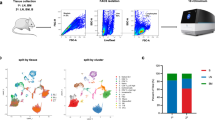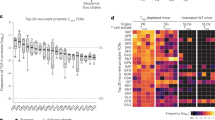Abstract
THYMUS-derived (T) cells have a major role in immune systems. They mediate various functions, such as T–B cooperation (‘helper cells’)1 and the mixed lymphocyte reaction2, become killer cells3, are active in graft versus host responses (reviewed in ref. 4) and act as suppressor cells5. The identification of the cells responsible for these functions as T cells was facilitated by the use of antisera against the T-cell-specific alloantigen, Thy-1 (ref. 6) (formerly known as θ). It has been reported that Ly allo-antigens, present exclusively on T cells7, identify functionally distinct subpopulations of T cells8. For example, T helper cells were lysed by anti-Ly–1, but not by anti-Ly–2, so that their phenotype is Ly–1+2−, whereas T killer cells were a distinct subpopulation, being Ly–1−2+. We report here that specific T suppressor cells induced in vitro have a different Ly alloantigen phenotype from T helper cells induced in vitro from the same spleen cell pool.
This is a preview of subscription content, access via your institution
Access options
Subscribe to this journal
Receive 51 print issues and online access
$199.00 per year
only $3.90 per issue
Buy this article
- Purchase on Springer Link
- Instant access to full article PDF
Prices may be subject to local taxes which are calculated during checkout
Similar content being viewed by others
References
Davies, A. J. S., Transplant. Rev., 1, 43–91 (1969).
Claman, H. N., and Chaperon, E. A., Transplant. Rev., 1, 92–113 (1969).
Wagner, H., Eur. J. Immun., 1, 498–499 (1971).
Cerottini, J. C., Nordin, A. A., and Brunner, K. T., Nature, 228, 1308–1309 (1970).
Asofsky, R., Cantor, H., and Tigelaar, R. E., Prog. Immun., 1, 369–381, (1971).
Gershon, R. K., Contemp. Topics Immunobiol., 3, 1–37 (1973).
Raff, M. C., Nature, 226, 1257–1258 (1970).
Boyse, E. A., Miyazawa, M., Aoki, T., and Old, L. J., Proc. R. Soc., B 170, 175–193 (1968).
Kisielow, P., et al., Nature, 253, 219–220 (1975).
Scheid, M., Boyse, E. A., Carswell, E. A., and Old, L. J., J. exp. Med., 135, 938–955 (1972).
Feldmann, M., Nature new Biol., 242, 82–84 (1973).
Hirst, J. A., Hoffmann, M. K., Kisielow, P., Frydecka, I., and Oettgen, H. F., J. Immun. (in the press).
Kontiainen, S., and Feldmann, M., Nature new Biol., 245, 285–286 (1973).
Cunningham, A., and Szenberg, A., Immunology, 14, 599–602 (1968).
Kontiainen, S., and Feldmann, M., Immun. (in the press).
Author information
Authors and Affiliations
Rights and permissions
About this article
Cite this article
FELDMANN, M., BEVERLEY, P., DUNKLEY, M. et al. Different Ly antigen phenotypes of in vitro induced helper and suppressor cells. Nature 258, 614–616 (1975). https://doi.org/10.1038/258614a0
Received:
Accepted:
Published:
Issue Date:
DOI: https://doi.org/10.1038/258614a0
This article is cited by
-
Tolerance, suppression and the fetal allograft
Journal of Molecular Medicine (2005)
-
Structure of antigen-specific suppressor factors: Current views
Survey of Immunologic Research (1982)
-
Precursor and effector phenotypes of activated human T lymphocytes
Nature (1980)
-
Basic strategies of the immune system in the regulation of antibody response
La Ricerca in Clinica e in Laboratorio (1980)
-
Induction of antigen-specific human suppressor T lymphocytes in vitro
Nature (1978)
Comments
By submitting a comment you agree to abide by our Terms and Community Guidelines. If you find something abusive or that does not comply with our terms or guidelines please flag it as inappropriate.



